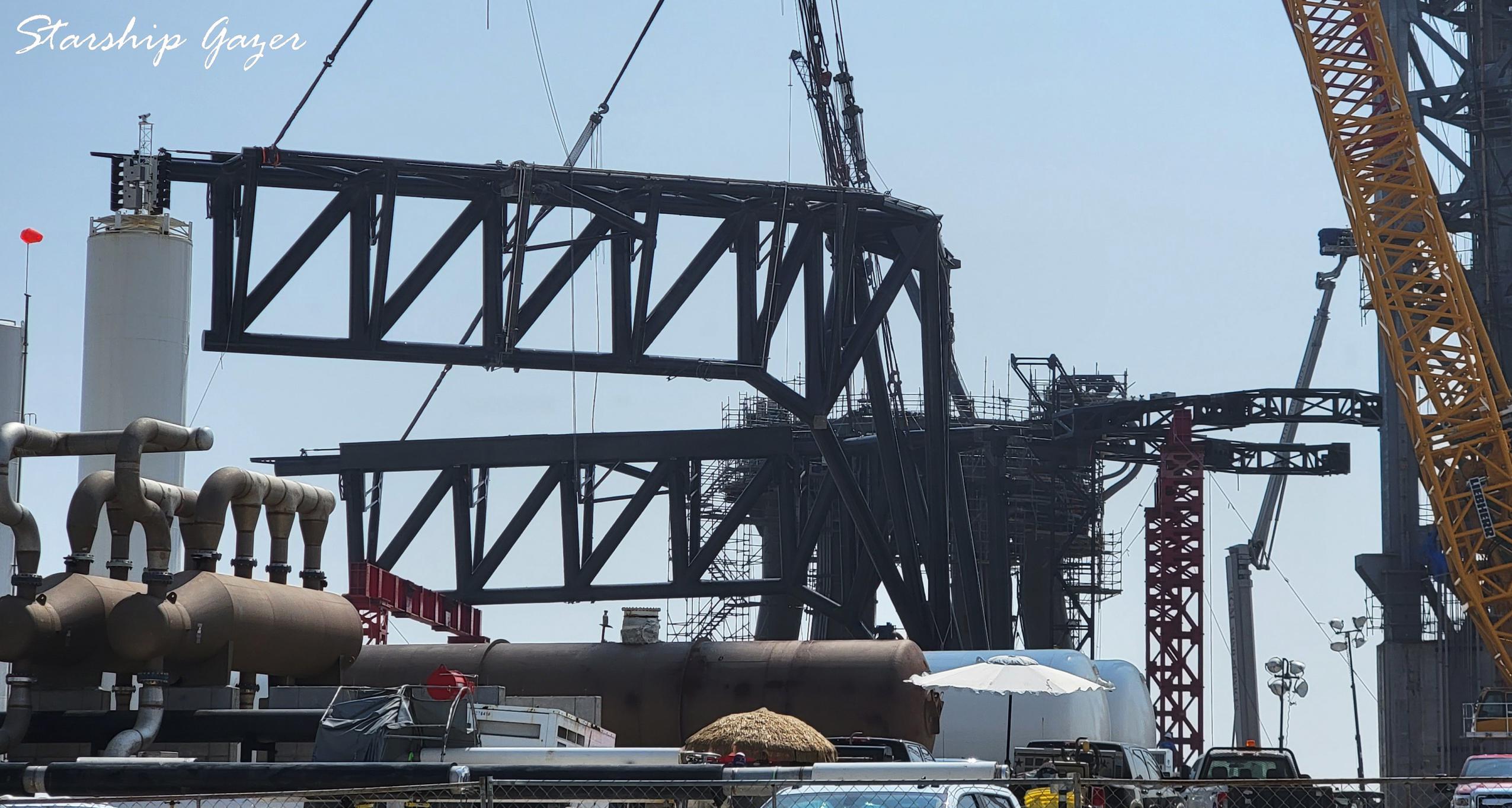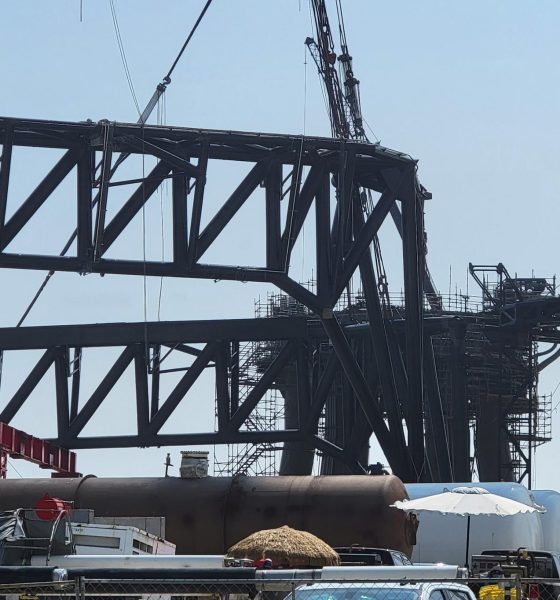

News
SpaceX’s rocket-catching ‘Mechazilla’ arms are almost ready to join Starship launch tower
Update: SpaceX has now lifted, flipped, and staged all three components of Starbase’s Mechazilla rocket-catcher, including two giant arms measuring some 36m (~120 ft) from tip to tower.
Currently hanging from both of SpaceX’s largest Starbase cranes, teams must now install massive steel pins to turn those three separate components – two arms and a carriage-like base – into an integrated structure ready for installation on the exterior of the first Starship launch tower. It’s unclear how long that might take but SpaceX is wasting no time and has already begun installing 12 ‘guide blocks’ that will allow the carriage and arms to slide up and down tracks affixed to three of four tower ‘legs.’
SpaceX has begun preparing its Starbase ‘launch tower’ for the installation of a pair of giant arms designed to lift, stack, and even catch Starships and Super Heavy boosters out of mid-air.
Deemed ‘Mechazilla’ by CEO Elon Musk, assembly of first of the structure’s three main arms only began in earnest in June 2021. That ‘quick disconnect’ (QD) arm – designed to fuel Starship and stabilize Super Heavy during Starship stacking – was installed on August 29th and followed by the addition of a claw-like appendage meant to grab onto boosters about a month later. Now, all that’s missing from Mechazilla’s first arm is the actual ‘quick-disconnect’ device that will connect to Starship’s umbilical panel to supply propellant, power, and communications links.
However, ever since Musk first hinted at the possibility of catching Super Heavy and Starship, the star of the Mechazilla show has always been its ‘chopsticks’ – SpaceX’s internal colloquialism for the pair of giant, moving arms meant to lift and catch rockets.
Prefabricated catch arm parts began to arrive at Starbase less than three months ago in the last week or two of July. Just a month later, the basic structure of both arms was practically complete, leaving another month for plumbing, wiring, and a number of smaller structural additions. Less than three months after the first parts arrived SpaceX lifted the catch arm ‘carriage’ – a sort of backbone that will hold both arms and attach to the launch tower – vertical to install it on a temporary jig.
Two days later, SpaceX lifted and flipped the first catch arm into the correct orientation with Starbase’s largest crane. To install both arms, though, it appears that SpaceX will need to have a second crane simultaneously lift and flip the second arm and move it into position so that a single giant steel pin can slot through both of their hinges. Perhaps because of the arrival of high winds on Sunday, the first (right) arm continues to hang from a crane just a few feet away from the arm carriage it will eventually be installed on, while the left arm has yet to move towards a second crane recently staged to lift it.
Ultimately, though, SpaceX is clearly ready to install both arms on the tower carriage. Once that process is complete, it appears that SpaceX will finish some minor carriage outfitting tasks before eventually installing the assembled carriage-and-arms structure onto the launch tower itself. It’s hard to say for sure but depending on the readiness of the complex system of pulleys and draw-works the tower needs to hold and move the carriage and arms, Mechazilla could effectively be fully installed and ready for testing by the end of the month. Stay tuned!

News
Tesla China quietly posts Robotaxi-related job listing
Tesla China is currently seeking a Low Voltage Electrical Engineer to work on circuit board design for the company’s autonomous vehicles.

Tesla has posted a new job listing in Shanghai explicitly tied to its Robotaxi program, fueling speculation that the company is preparing to launch its dedicated autonomous ride-hailing service in China.
As noted in the listing, Tesla China is currently seeking a Low Voltage Electrical Engineer to work on circuit board design for the company’s autonomous vehicles.
Robotaxi-specific role
The listing, which was shared on social media platform X by industry watcher @tslaming, suggested that Tesla China is looking to fill the role urgently. The job listing itself specifically mentions that the person hired for the role will be working on the Low Voltage Hardware team, which would design the circuit boards that would serve as the nervous system of the Robotaxi.
Key tasks for the role, as indicated in the job listing, include collaboration with PCB layout, firmware, mechanical, program management, and validation teams, among other responsibilities. The role is based in Shanghai.
China Robotaxi launch
China represents a massive potential market for robotaxis, with its dense urban centers and supportive policies in select cities. Tesla has limited permission to roll out FSD in the country, though despite this, its vehicles have been hailed as among the best in the market when it comes to autonomous features. So far, at least, it appears that China supports Tesla’s FSD and Robotaxi rollout.
This was hinted at in November, when Tesla brought the Cybercab to the 8th China International Import Expo (CIIE) in Shanghai, marking the first time that the autonomous two-seater was brought to the Asia-Pacific region. The vehicle, despite not having a release date in China, received a significant amount of interest among the event’s attendees.
Elon Musk
Elon Musk and Tesla AI Director share insights after empty driver seat Robotaxi rides
The executives’ unoccupied tests hint at the rapid progress of Tesla’s unsupervised Robotaxi efforts.

Tesla CEO Elon Musk and AI Director Ashok Elluswamy celebrated Christmas Eve by sharing personal experiences with Robotaxi vehicles that had no safety monitor or occupant in the driver’s seat. Musk described the system’s “perfect driving” around Austin, while Elluswamy posted video from the back seat, calling it “an amazing experience.”
The executives’ unoccupied tests hint at the rapid progress of Tesla’s unsupervised Robotaxi efforts.
Elon and Ashok’s firsthand Robotaxi insights
Prior to Musk and the Tesla AI Director’s posts, sightings of unmanned Teslas navigating public roads were widely shared on social media. One such vehicle was spotted in Austin, Texas, which Elon Musk acknowleged by stating that “Testing is underway with no occupants in the car.”
Based on his Christmas Eve post, Musk seemed to have tested an unmanned Tesla himself. “A Tesla with no safety monitor in the car and me sitting in the passenger seat took me all around Austin on Sunday with perfect driving,” Musk wrote in his post.
Elluswamy responded with a 2-minute video showing himself in the rear of an unmanned Tesla. The video featured the vehicle’s empty front seats, as well as its smooth handling through real-world traffic. He captioned his video with the words, “It’s an amazing experience!”
Towards Unsupervised operations
During an xAI Hackathon earlier this month, Elon Musk mentioned that Tesla owed be removing Safety Monitors from its Robotaxis in Austin in just three weeks. “Unsupervised is pretty much solved at this point. So there will be Tesla Robotaxis operating in Austin with no one in them. Not even anyone in the passenger seat in about three weeks,” he said. Musk echoed similar estimates at the 2025 Annual Shareholder Meeting and the Q3 2025 earnings call.
Considering the insights that were posted Musk and Elluswamy, it does appear that Tesla is working hard towards operating its Robotaxis with no safety monitors. This is quite impressive considering that the service was launched just earlier this year.
Elon Musk
Starlink passes 9 million active customers just weeks after hitting 8 million
The milestone highlights the accelerating growth of Starlink, which has now been adding over 20,000 new users per day.

SpaceX’s Starlink satellite internet service has continued its rapid global expansion, surpassing 9 million active customers just weeks after crossing the 8 million mark.
The milestone highlights the accelerating growth of Starlink, which has now been adding over 20,000 new users per day.
9 million customers
In a post on X, SpaceX stated that Starlink now serves over 9 million active users across 155 countries, territories, and markets. The company reached 8 million customers in early November, meaning it added roughly 1 million subscribers in under seven weeks, or about 21,275 new users on average per day.
“Starlink is connecting more than 9M active customers with high-speed internet across 155 countries, territories, and many other markets,” Starlink wrote in a post on its official X account. SpaceX President Gwynne Shotwell also celebrated the milestone on X. “A huge thank you to all of our customers and congrats to the Starlink team for such an incredible product,” she wrote.
That growth rate reflects both rising demand for broadband in underserved regions and Starlink’s expanding satellite constellation, which now includes more than 9,000 low-Earth-orbit satellites designed to deliver high-speed, low-latency internet worldwide.
Starlink’s momentum
Starlink’s momentum has been building up. SpaceX reported 4.6 million Starlink customers in December 2024, followed by 7 million by August 2025, and 8 million customers in November. Independent data also suggests Starlink usage is rising sharply, with Cloudflare reporting that global web traffic from Starlink users more than doubled in 2025, as noted in an Insider report.
Starlink’s momentum is increasingly tied to SpaceX’s broader financial outlook. Elon Musk has said the satellite network is “by far” the company’s largest revenue driver, and reports suggest SpaceX may be positioning itself for an initial public offering as soon as next year, with valuations estimated as high as $1.5 trillion. Musk has also suggested in the past that Starlink could have its own IPO in the future.








